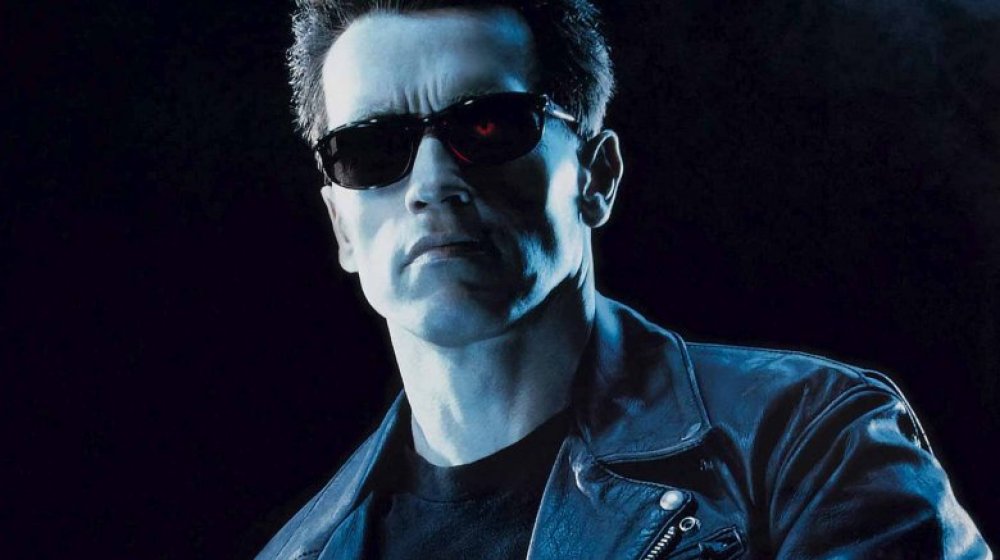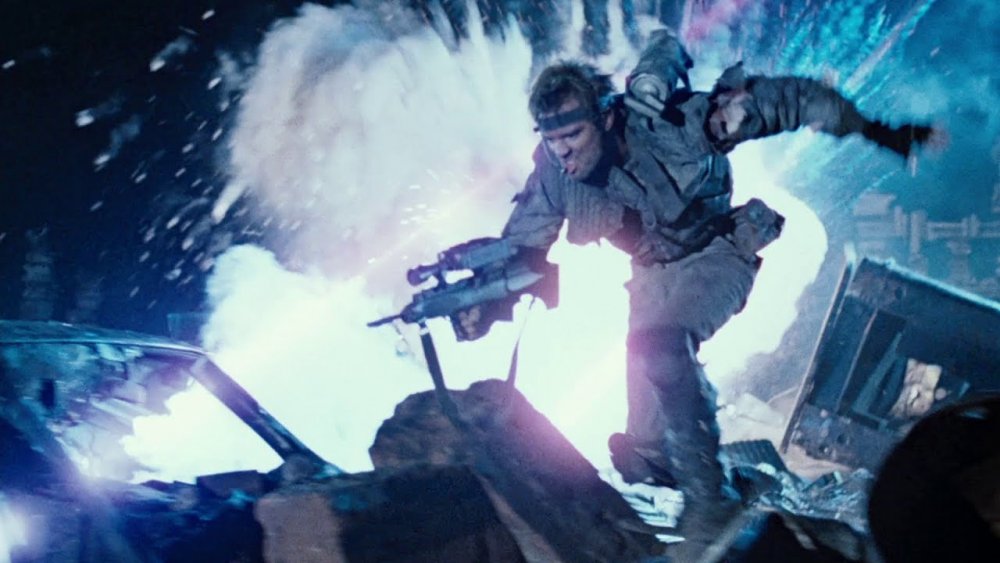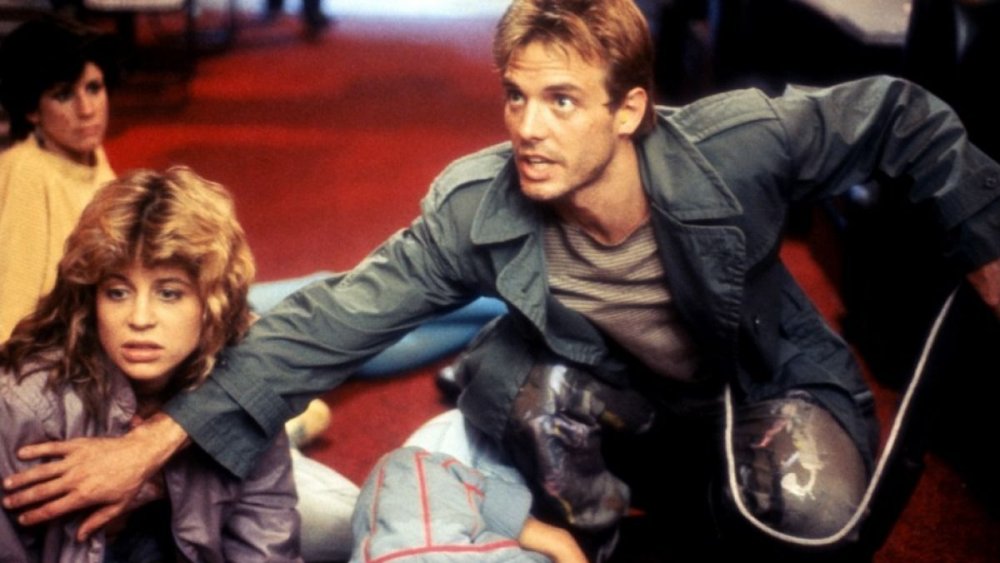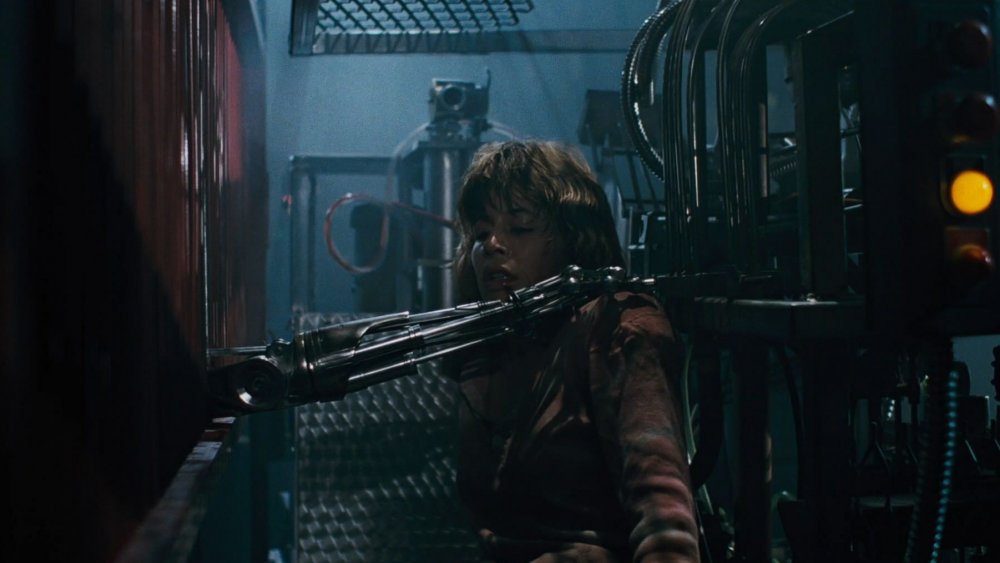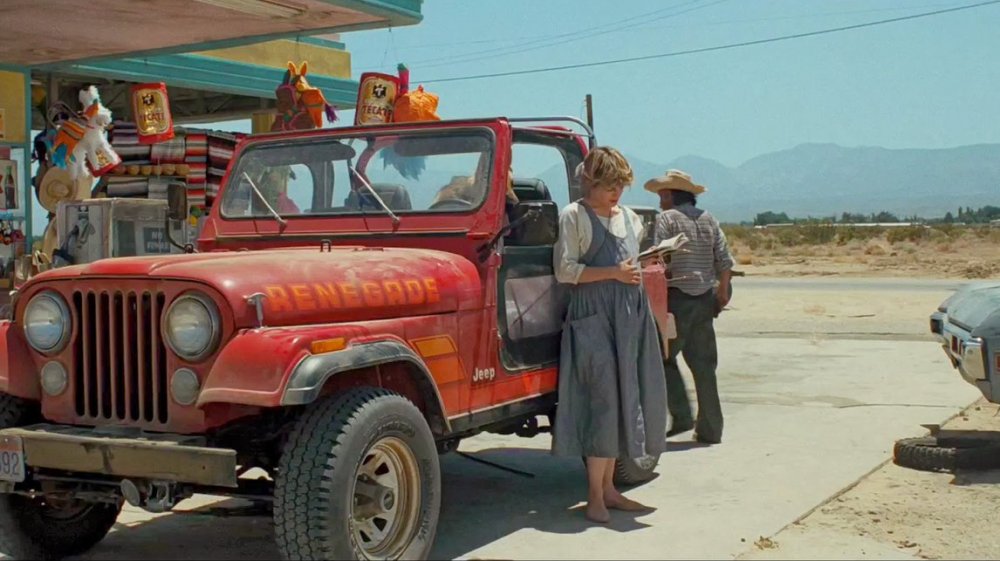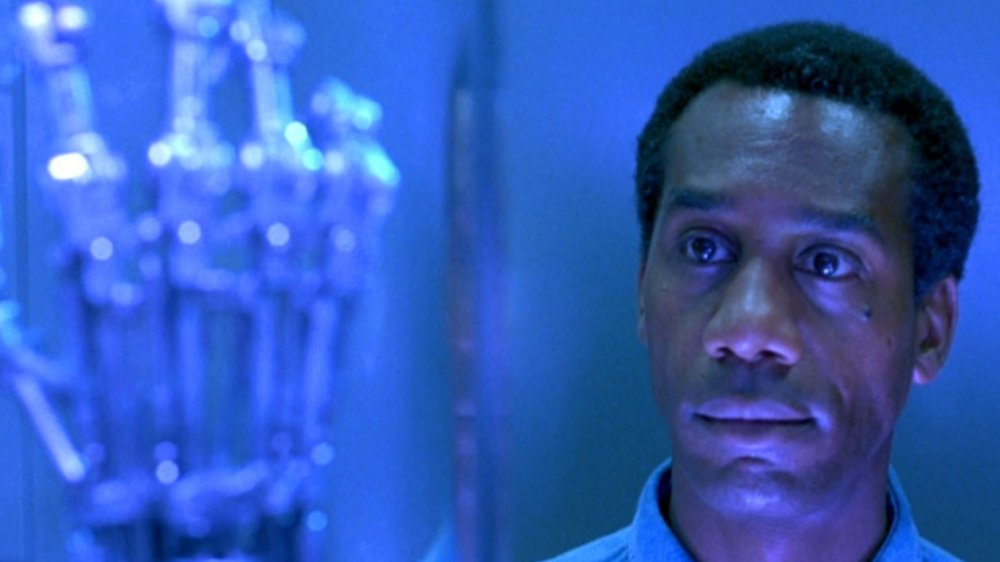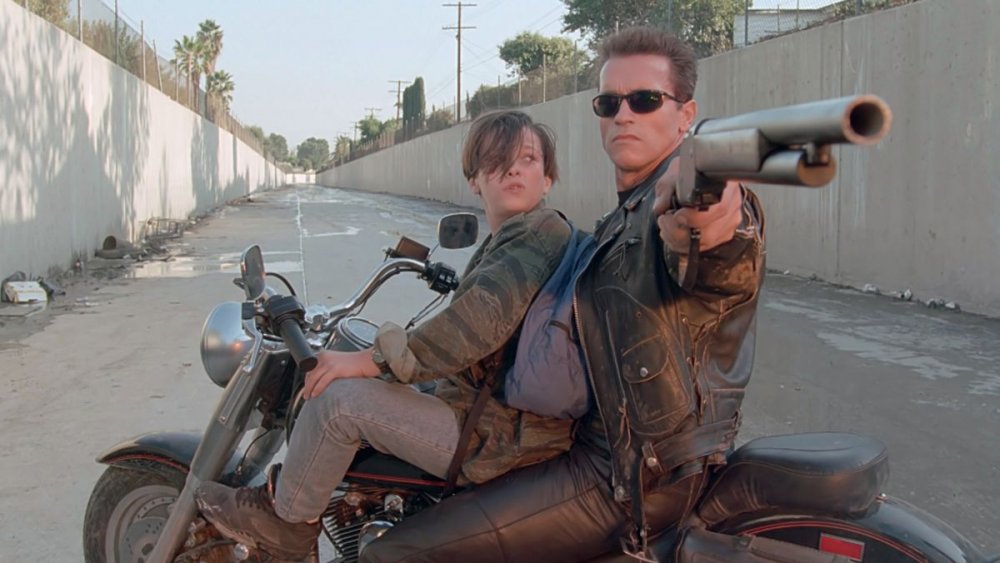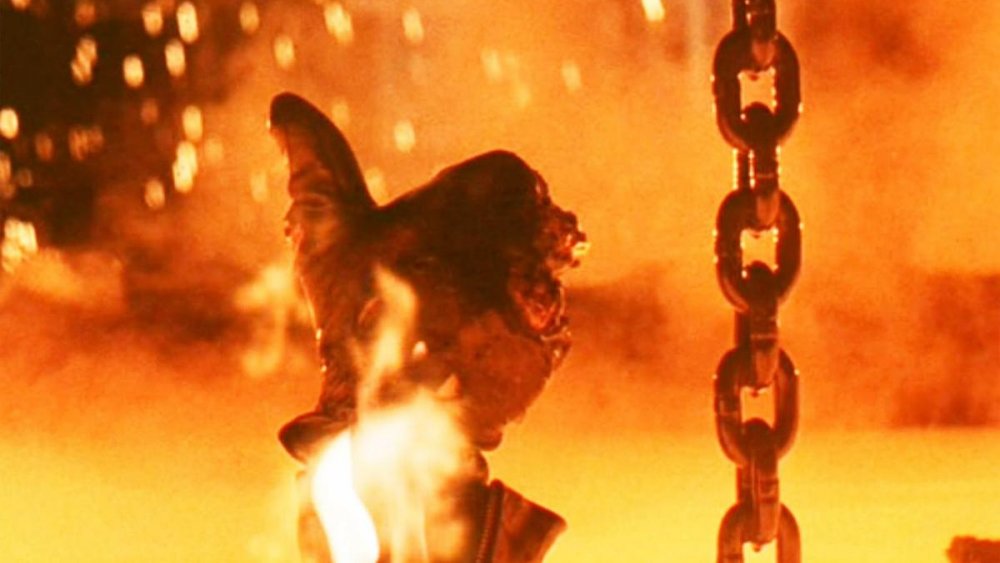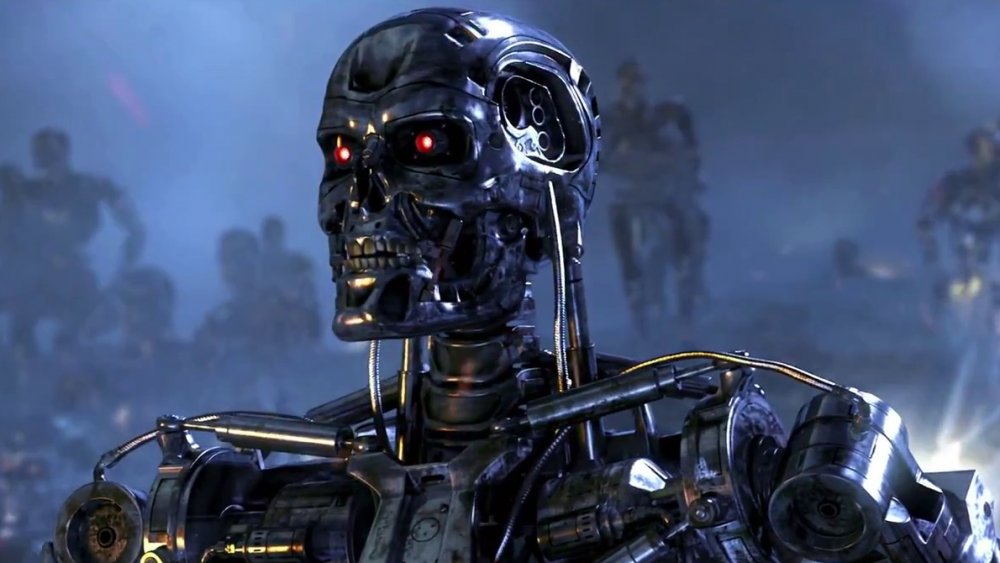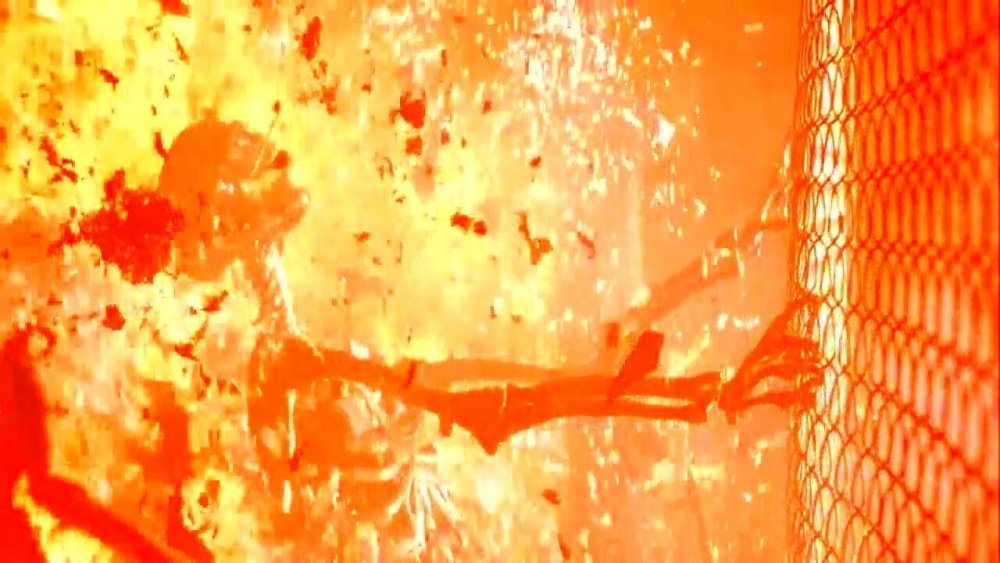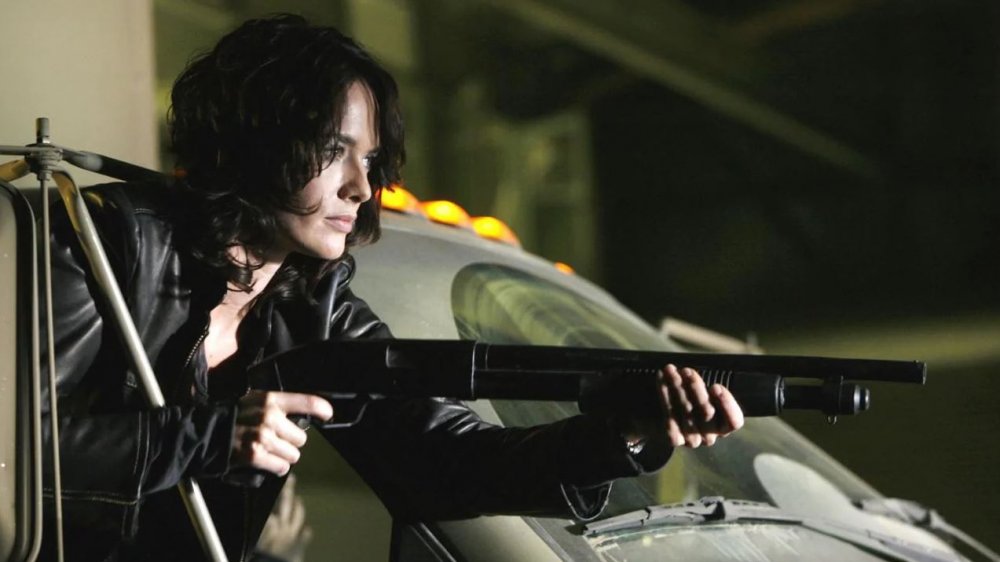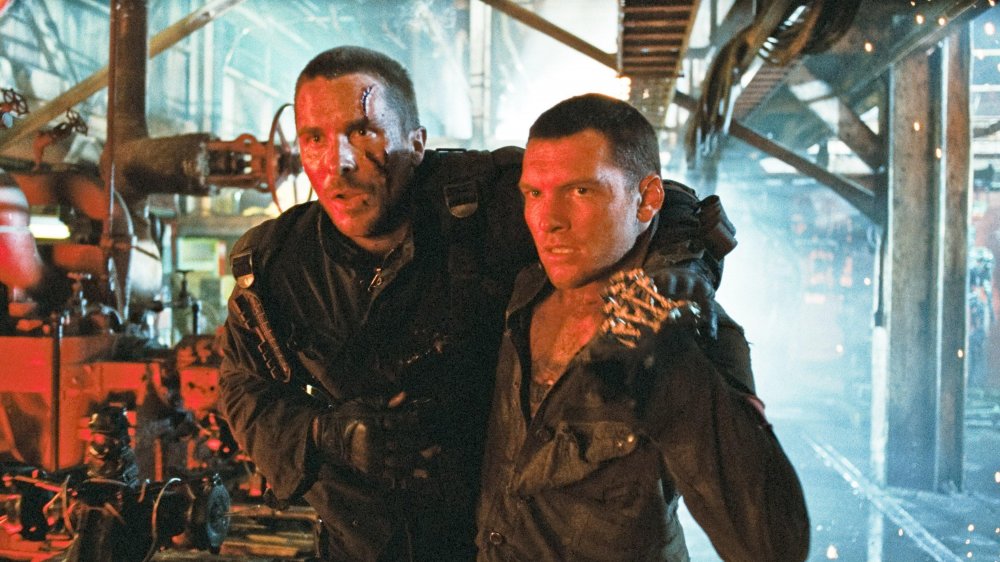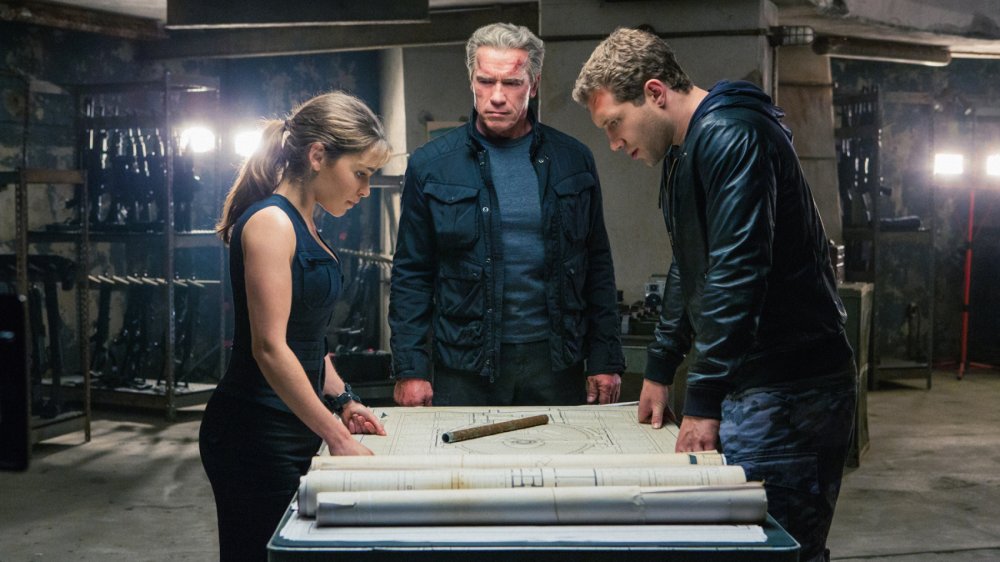The Complicated Terminator Franchise Timeline Explained
Time travel stories are often full of crazy variables, paradoxes, and plot holes. That's especially true for The Terminator franchise. Originally created by James Cameron, the core story of the series is so compelling that filmmakers can't help but try their hand at it, despite all its timey-wimey weirdness. After all, the central idea of a human-led resistance against bloodthirsty machines, coupled with the endless possibilities of time travel, is screenwriter catnip.
Of course, with such a major franchise, new fans can have a bit of trouble getting things straight. After all, there are six films and a TV series (and, oh yeah, an amusement park ride). Each installment has waded into the river of time and kicked up a lot of silt, making it hard to see anything clearly. But like each new Terminator director, we're going to do our best to set things straight.
Today, we're going to focus on this crazy tale of time-traveling robots, from the origins of Skynet to the endless cybernetic showdowns. We'll be going from the original film to Dark Fate, so come with us if you want to understand. This is the complicated Terminator franchise explained.
The Terminator timeline starts with a dark future
In the world of The Terminator, humans create advanced supercomputers that eventually become self-aware enough to realize when they're being threatened. When scientists realize this computer network has become sentient, they attempt to shut their creation down. Seeing humans as an existential threat, the ultra-smart machines set about systematically wiping them out.
In 1997, the computers take control of the United States' nuclear arsenal and use it to kill as much of the human population as possible. The few surviving humans build an underground resistance, hiding from weapons and robots built by the intelligent computer network (known as Skynet) to hunt them down and exterminate them. This resistance is led by one man — John Connor. As a general in the future, he successfully turns the tide against the machines and has them on their cybernetic heels. In the year 2029, he leads the most successful attack on the computers since their first strike, effectively shutting down Skynet by destroying their defense systems in what was once Colorado.
Skynet recognizes that Connor will be the biggest threat to its continued existence post-2029. Much in the same way that it launched the missiles on what came to be known as "Judgment Day" back in '97, the computer network makes moves to ensure its own survival. It sends back a killer cyborg with the mission to kill Connor's mother before John can be born.
Dueling time-travelers
The first film in the Terminator series begins with John Connor and Skynet having sent back representatives using a time machine (or "time displacement device") to prevent their own respective extinctions. Knowing that Skynet has sent a Terminator — specifically, a musclebound T-800 (Arnold Schwarzenegger) — to kill his mother, Connor sends back one of his own soldiers, Kyle Reese (Michael Biehn), in a military action called "Operation Chrono."
The two time-travelers arrive in Los Angeles in 1984 with nothing but the skin (or organic matter) on their backs. The two quickly set about acquiring clothing and weapons, and needless to say, the Terminator's shopping methods are a bit more murderous. Then, in their search for John's mother, Sarah Connor (Linda Hamilton), the two hit upon the same idea — consult the local phone book. Weapon in hand, the T-800 begins systematically slaughtering every Sarah Connor in Los Angeles.
Fortunately, the mother of mankind's messiah is smart enough to realize she's on a hit list. Working as a diner waitress, Sarah sees news reports that women with her name are being murdered, and she eventually winds up hiding in a nightclub called Tech Noir where she calls the cops. But before the boys in blue can show up, both the T-800 and Kyle Reese stumble into the club, guns a-blazing. Reese rescues Sarah, but as they try to escape the Terminator, they run afoul of the police, ultimately getting themselves arrested.
Sarah Connor is (briefly) victorious
Once the cops chase them down, Kyle Reese is grilled by the police and psychologists who question his story about being a time-traveler from the future, sent to save the last hope of human resistance against militant machines. Unfortunately, while Reese is being detained, the robotic serial killer tracks Sarah down to the police station, and after ramming his car through the front desk, proceeds to murder every single police officer in the precinct.
Forced to go on the run again, Kyle and Sarah hide out in a hotel, and at that point, Kyle shares that he's in love with Sarah. In fact, he's been obsessing over her ever since John first showed him her picture in the 2020s. Eventually, they carve some time out of the flight for their lives and have sex.
But the Terminator has no time for love, and after murdering Sarah's mother and impersonating her voice over the phone, he finds our heroes yet again, leading to a final fight. In the big showdown, Sarah and Kyle battle the T-800 with pipe bombs, exposing his true cybernetic skeleton. Eventually, the trio wind up in a factory where Kyle dies from injuries sustained in the fight, and Sarah crushes the Terminator to death with a hydraulic press.
Paradoxes on paradoxes in The Terminator
Even the tightest writing can't avoid hitting a few paradoxes when dealing with time travel, but The Terminator franchise stakes its claim as the king of time-travel movies by steering into the skid. The paradoxes are baked into the films from the very beginning, and the movies make no effort to hide it. In short, the whole thing is built upon the "predestination paradox" — the idea that someone could travel to the past and affect the future in a way that necessitates them traveling to the past in the first place. The entire Terminator universe spawns from this one impossibility, as laid out in the coda of the first film.
The Terminator ends with a pregnant Sarah Connor driving through Mexico. Via audio tapes that she's recording for her unborn son, John, we learn that Kyle Reese is the father. When she stops for gas, a child snaps her photo and sells the Polaroid to her ... and it's the very same one that John Connor gave to Reese in the future. In short, John knew that Reese was his father and sent him back in time so that he could protect his mother. By sending him back, John created the circumstances of his birth, which would eventually lead to him fronting the resistance. However, that fight against Skynet would lead to them sending back the Terminator and would produce the need to send Reese back and save his mother's life. And so on and so forth for eternity.
To be a fan of James Cameron's time-travelling classic, you just have to try and not think about it too hard, lest you give yourself a nosebleed.
He'll be back
The humans aren't the only ones locked in an eternal loop. The spare parts of the Terminator found in the factory after Sarah Connor's brush with death are soon found by researchers from Cyberdyne Systems who are working on advanced computers and robotics. In other words, the building blocks of Skynet are created by unwitting scientists using the technology left behind after Skynet sent a murderous robot from the future to protect itself.
As for Sarah, in between the first and second film, she travels through Latin America with her young son. She befriends various guerrilla fighters and military men in order to train her son to be a resistance fighter in the future war against the machines. She explains this to John before going off to attack a factory building the computer components that will become Skynet. When she's arrested, she reveals the future attack by the machines is imminent, and naturally, she's promptly locked away in a mental institution. This leads a ten-year-old John to believe his mother is merely insane, although he uses the skills he was taught to pull off minor scams and crimes under the noses of his foster parents.
It takes a killer to stop a killer
After it's first failed attempt to snuff out John Connor, Skynet is ready for round two, sending back another, newer Terminator to 1995 to kill the preteen John (Edward Furlong). Adult John knows this is going to happen, as he's already lived it, so he sends back a reprogrammed version of the original Terminator model to protect his younger self. Terminator 2: Judgment Day largely consists of the duel between this newer, shape-shifting Terminator and the older model.
After saving young John from being run down by the liquid metal T-1000 (Robert Patrick), the friendly T-800 helps break Sarah Connor out of her mental institution. They come across Sarah in the midst of her own escape, helping her outrun both the authorities and the robot sent back to wipe the Connor clan off the planet. Sarah's first instinct is to head back to Mexico, where she stocks up on weaponry while hiding with some sympathetic friends. When the T-800 reveals the name of a computer scientist who's credited with starting Skynet — engineer Miles Bennett Dyson (Joe Morton) — Sarah sets off on her own to kill him.
Horrified that his mother would kill a man in cold blood, John Connor gives chase with the T-800, and they find Sarah inside Dyson's home. But when they enter, they find that Sarah couldn't bring herself to kill Dyson in front of his family. Instead, the trio explain to the scientist that his work will lead to the end of the world as we know it. Having seen the robot components of the T-800 firsthand, Dyson believes their story and goes along to help them destroy his research (particularly the left-behind components of the original Terminator).
Terminator 2: Judgment Day ends with a bittersweet battle
With Dyson's help, our heroes break into the Cyberdyne labs and steal the original Terminator components. They set a bomb to destroy the entire lab, but they're interrupted by the police. The cops shoot and kill Dyson as the Terminator and his team escape, but the engineer is able to detonate the bomb. Of course, that doesn't mean the T-1000 is going to slow down, and he keeps on chasing after his prey.
After a pretty epic chase with the new and improved Terminator, Sarah, John, and the T-800 ultimately square off against their enemy in a foundry. However, the older Terminator model is bested by next century's model, and the T-1000 impales the old protector robot and leaves him for dead. In fact, he very nearly traps and kills John by impersonating his mother, but the Connors — with the help of their barely-holding-it-together robo-buddy — are able to knock the killer Terminator into a vat of molten steel.
Happy ending, right? Well, not quite. In one of the saddest last moments in movie history, the T-800 willingly dips himself into the boiling vat to destroy himself. This way, any parts of him that might be used to build Skynet will be incinerated.
The Terminator timeline gets dark with Rise of the Machines
The good times are no match for time's inelasticity. The events of the future have to happen for the past to play out the way it has. Skynet will happen. Judgment Day will happen. All that matters is that John Connor is there to rally mankind and fight the machines.
There are some signs of hope, but you won't find them in Terminator 3: Rise of the Machines. Sure, the initial date of Judgment Day has come and gone without the world turning to a cinder. But John Connor (Nick Stahl) is living as a hermit, hiding from machines in an off-the-grid home after his mother has died of cancer. In fact, John is steadily losing his mind by waiting for Judgment Day.
Worse still, Skynet sends back a more advanced Terminator, hoping to kill key members of the human resistance so they won't become a thorn in Skynet's shiny, metal side. A T-X model Terminator (Kristanna Loken) targets John, as well as his future wife, and of course, they're protected by yet another reprogrammed Terminator. However, this friendly Terminator comes bearing bad news. He tells John that, yeah, the end of the world is coming. The events of Terminator 2: Judgment Day delayed the nuclear holocaust, but it will still happen, and he's been sent back into the past to carry Connor and his partner, Kate (Claire Danes), away from the blast.
The end of the world as we know it
After learning that Judgment Day is on the way, John orders the Terminator to take them to Kate's father, a high-ranking Air Force official. However the Terminator refuses, only obeying when Kate repeats the order. The Terminator then reveals that in the future, he killed John and then was captured, reprogrammed, and sent to the past on Kate's orders.
Eventually, our heroes try to stop the military from working on the technology that will become Skynet, but the computers begin to take over the weapons systems before John and Kate succeed. Tragically, Kate's father is killed after the T-X activates the weapons systems in his lab, but before he dies, he reveals the location of Skynet's core.
John and company then head toward Crystal Peak, Colorado, in the hopes of destroying Skynet. As they make their way to the location, the Terminator repeatedly throws himself between a pursuing T-X and the two would-be freedom fighters. But when they finally reach Crystal Peak, they realize it was all for naught. Kate's father wasn't telling them how to destroy Skynet. Instead, Crystal Peak is a fallout shelter for high-ranking military members. He knew Judgment Day was coming and wanted them to survive.
The movie ends with Skynet launching its attack on humanity, unleashing nukes and murdering billions of people. John takes command of a radio in the shelter and sets about becoming the resistance leader he was destined to be.
Enter The Sarah Connor Chronicles
Terminator: The Sarah Connor Chronicles is the first major deviation we see from the original trilogy, setting the tone for a decade of alternate timelines and reimaginings.
This 2008 series jettisons the events of T3 and follows John (Thomas Dekker) and Sarah Connor (Lena Headey) as they attempt to hide from dueling antagonists in the immediate wake of Terminator 2: Judgement Day. As John and Sarah are believed to be responsible for the death of engineer Miles Dyson, they live in fear of the FBI capturing them. At the same time, they're fully aware that more Terminators could be sent back by Skynet to finish the job they failed in the first two films. In fact, one of those villainous robots does eventually show up. At this point, a protective Terminator named Cameron (Summer Glau) appears at John's school to ward off any attacks, and eventually, our heroes learn they must travel through time, from 1999 to 2007, if they want to stop Judgment Day.
The Sarah Connor Chronicles is the first Terminator offering to deviate heavily from its ideas of predestination and causality loops. When Sarah and John do eventually travel through time in the series, they don't find older versions of themselves. In the years between their origin and their destination, they didn't exist. When John Connor closes the series by jumping far in the future to stay alive, he finds that the war with the machines is ongoing and the human resistance has formed without him.
Salvation shines a light on John Connor's war years
The original Terminator trilogy is grim, but it's a nearly perfect closed loop. Everything had to happen because it's already happened in the future. Even if it all leads to the apocalypse and a bleak future of tooth-and-nail battles against superpowered killing machines, it all had to happen to create John Connor.
Still, the idea of John Connor's war years was too good for Hollywood to pass up, and we returned to the Terminator universe with Terminator Salvation. In this particular tale, we meet a war-hardened John Connor (Christian Bale) as he leads an ultimately successful raid against Skynet. While the main point of the film is to show guerrilla soldiers pulling off something cool against the big bad machines, Salvation does give us a glimpse of the creation of the T-800.
In fact, John throws down against the hulking monster during his attack on Skynet headquarters, and he very nearly dies in the process, as the machines have intentionally guided him to the base in the hopes of finally killing him. They're almost successful, but an android named Marcus (Sam Worthington) who was initially a pawn in Skynet's schemes sacrifices himself to keep John alive.
The Terminator timeline starts getting really wonky
The Terminator timeline really goes off the rails after Salvation, courtesy of 2015's Terminator Genisys, with its bold departure from both franchise chronology and accepted English spellings. The reboot rethinks the original series by playing with the events of the very first film. In Genisys, Kyle Reese (Jai Courtney) is still sent back from the future by his commander, John Connor (Jason Clarke). However, when he shows up in 1984, he finds it's been deeply altered from the '84 that fans all know. In this new timeline, Sarah Connor (Emilia Clarke) has been raised from childhood by a reprogrammed Terminator.
The old Terminator, nicknamed "Pops" and played by an age-appropriate Arnold, has protected Sarah Connor from attacks by Terminators after her parents were killed by an even earlier Terminator. Sarah and Pops have built a time machine to help fight Skynet, and Sarah wants to travel to the original era of Judgement Day to stop Skynet. However, Kyle Reese convinces them to head to 2017 to avert a disaster he saw in visions from his childhood.
The movie jumps through causality hoops, with a Terminator version of John Connor traveling to 2017 in an attempt to stop their plot to destroy Skynet (now known as Genisys). The Terminator John was created after Skynet fused the real John with machine matter, and they used him to insure Skynet's survival throughout time. While the trio of Kyle, Pops, and Sarah are successful in their attack on the Genisys system, a post-credits scene reveals that the core of Genisys was unaffected, setting the stage for more sequels (that fell through).
The end of the Terminator timeline?
Given how jumbled the timeline was, the team behind Terminator: Dark Fate decided to jettison the baggage of any movie not made by James Cameron. They ejected T3, Salvation, Genisys, and even the T2 ride (which strangely took the young John Connor into the future to defeat Skynet by battling a Terminator spider called the T-1000000). Their answer to the franchise's Gordian knot of timelines was to chop the parts they didn't need and to keep things moving.
However, rather than having John lead the resistance, Dark Fate posited that John was killed by yet another Terminator in the year 1998. He was assassinated while living in Latin America with his mother, and the movie focuses on Sarah's attempts to protect the new human savior, Dani Ramos (Natalia Reyes). Together, Sarah and a cyborg super soldier named Grace (Mackenzie Davis) protect Dani from an advanced Terminator called Rev-9 (Gabriel Luna).
On top of all that, the trio find themselves on a sci-fi quest. See, Sarah knew about Dani because an unknown source was sending her messages detailing the mission of each Terminator sent into the past. Hoping to find the source of the messages, the heroes set out on their journey, all while keeping Dani alive through constant attacks from Rev-9. Oh, and just to make things even more complicated, Grace reveals that Skynet doesn't exist in her future, but an analog called Legion is following the same path.
When the three heroes track down the messages' origin point, Sarah is shocked to find the same T-800 that killed her son. As it turns out, he was stranded in the past when his alteration of time led to Skynet no longer existing. Without a mission or superiors, the T-800 worked to assimilate into human society. Ultimately, he came to feel guilty for his actions against humanity, and he decided to help Sarah via those aforementioned messages as a way to clean his conscience.
Eventually, our band of misfits hatch a plan to destroy Rev-9, but it falls apart catastrophically in their final confrontation. Grace is killed in the fight, and the guilt-ridden T-800 drags the Rev-9 into an exploding machine, destroying both robots. Dark Fate (and the series so far) ends with Dani and Sarah watching a young Grace play on a playground, hoping to avoid the situation that led to her death.
